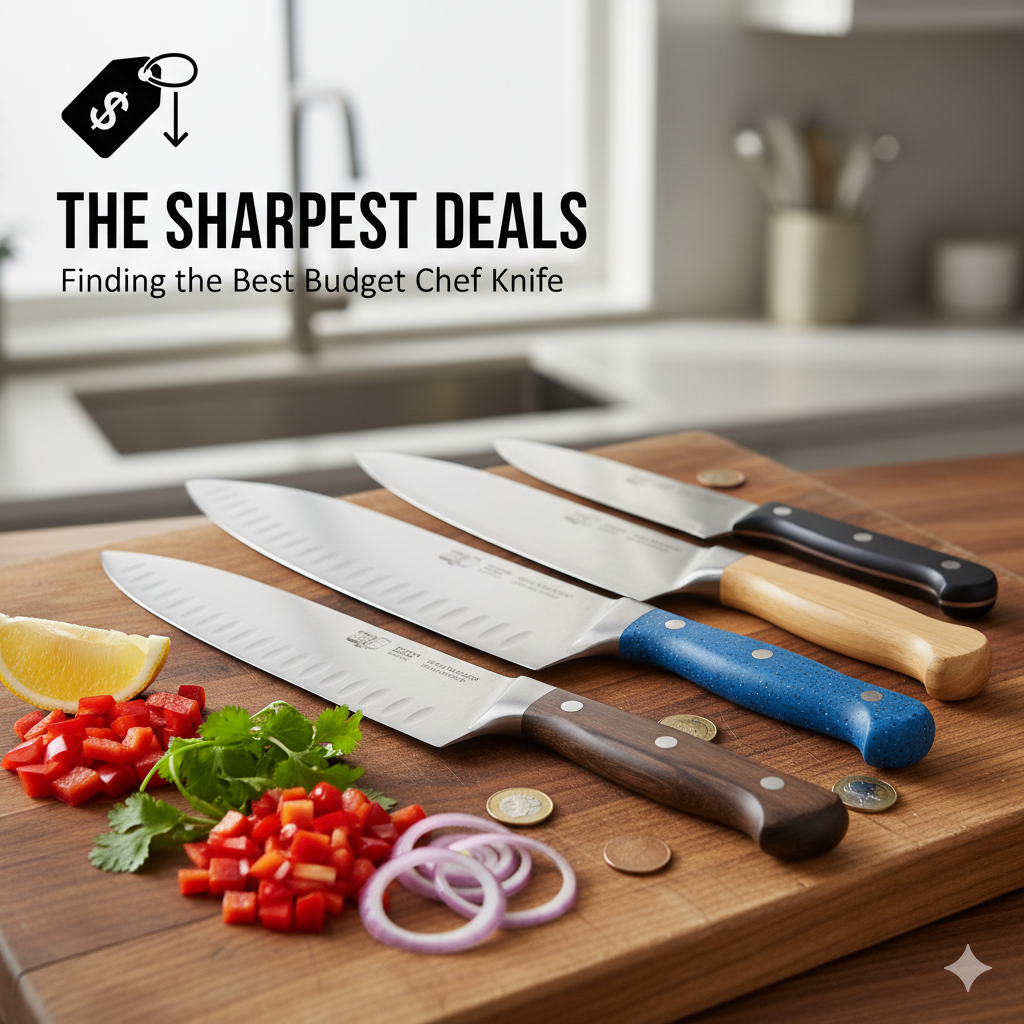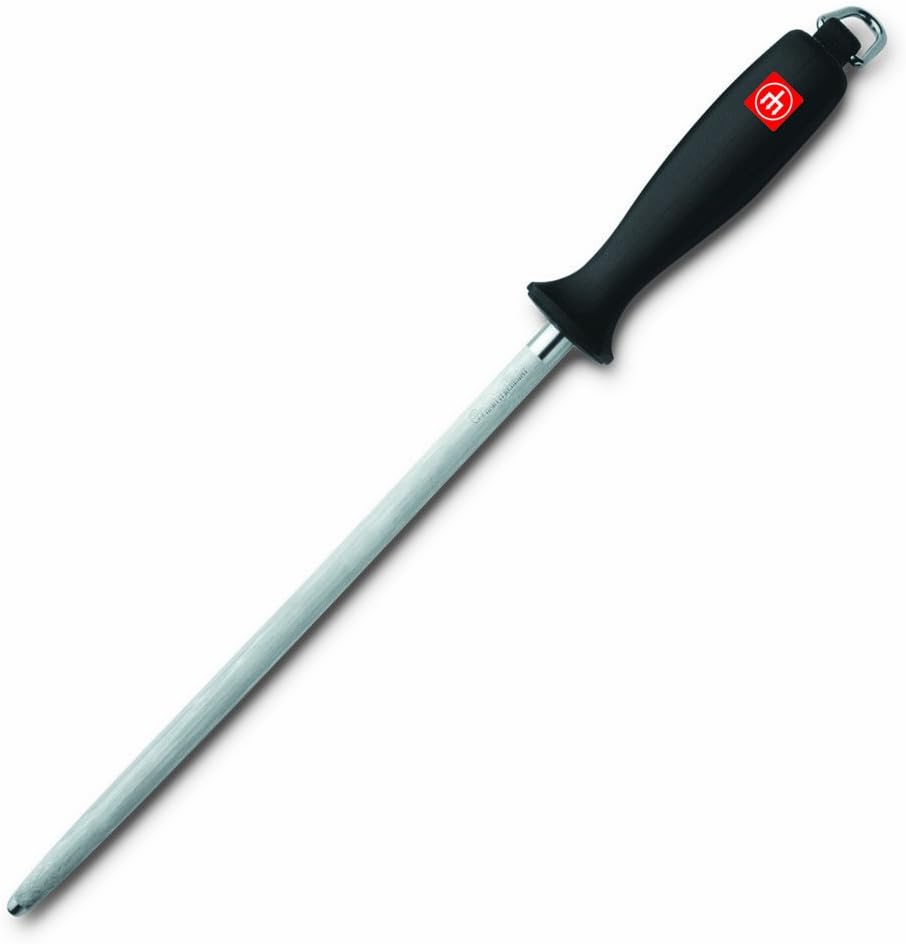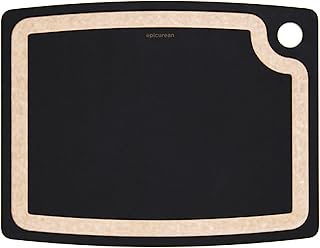The Sharpest Deals: Finding the Best Budget Chef Knife in 2025
Forget everything you’ve been told about needing to spend hundreds of dollars on a good kitchen knife. We’ve chopped, diced, and sliced our way through a mountain of produce to prove one thing: a phenomenal chef knife doesn’t have to break the bank. Welcome to the definitive guide to finding your kitchen’s new MVP—on a budget.

My Journey from Dull Blades to Budget Brilliance
I’ll be honest. For years, I was a kitchen tool skeptic. I used the cheap, flimsy knife that came in a block set I got as a housewarming gift. Prepping dinner was a chore. Dicing an onion felt like a wrestling match, and slicing a tomato? It was more like crushing it into a pulpy mess. I assumed this was just how cooking was.
My “aha!” moment came while helping a friend cook dinner. He handed me his chef knife, a blade that looked unassuming but felt different. It glided through a carrot with an almost silent *thunk*. It created paper-thin slices of garlic. The balance was perfect. I asked him how much the magic wand cost, expecting a number in the hundreds. He just laughed. “Forty bucks,” he said. “It’s a Victorinox.” That night changed everything. I realized that the secret to better, faster, and more enjoyable cooking wasn’t a fancy stove or expensive pans—it was a single, affordable, high-quality chef knife. This guide is the result of my obsession since that day: finding the absolute best affordable chef knives that punch way above their weight class.
Our Testing Criteria: What Makes a GREAT Budget Chef’s Knife?
To separate the true bargains from the cheap junk, we evaluated each knife based on a rigorous set of criteria that matters most in a real American kitchen. We didn’t just look at sharpness out of the box; we considered how the knife would perform after months of use.
Our Core Philosophy: A budget knife should never feel like a compromise. It should be a tool that inspires confidence, makes cooking easier, and offers incredible long-term value.
- Blade Material & Sharpness: We prioritized high-carbon stainless steel, which offers the best of both worlds: the sharpness and edge retention of carbon steel and the corrosion resistance of stainless steel. We tested each knife’s out-of-the-box sharpness on paper, tomatoes, and onions.
- Ergonomics & Comfort: How does it feel in your hand after 10 minutes of dicing? We looked for comfortable, non-slip handles that reduce fatigue. A knife’s balance is critical; it shouldn’t feel too blade-heavy or handle-heavy.
- Construction & Durability: We examined the build quality. Is it a full-tang construction (where the blade metal extends all the way through the handle)? How is the handle affixed to the blade? These factors are crucial for longevity and safety.
- Edge Retention & Ease of Maintenance: A knife that’s sharp today but dull tomorrow is useless. We assessed how well each blade held its edge and how easy it was to bring back to a razor-sharp state with a simple honing steel or sharpener.
- Overall Value: This is the ultimate test. Does the knife’s performance justify its price? The knives that made our list aren’t just cheap; they offer a return on investment that rivals blades costing three or four times as much.
Quick Picks: The Best Budget Chef Knives of 2025
Don’t have time for the details? Here are our top three picks that deliver outstanding performance and value.
| Knife | Image | Best For | Price | Check on Amazon |
|---|---|---|---|---|
| Victorinox Fibrox Pro 8-Inch |  |
Overall Best Value | ~ $60.99 | View Price |
| Mercer Culinary Millennia 8-Inch |  |
Best for Beginners | ~ $18.74 | View Price |
| Henckels Classic 8-Inch |  |
Best Forged Option | ~ $71.95 | View Price |
In-Depth Reviews: The Top 5 Budget Workhorses
Now, let’s dive deep into what makes each of our top picks a winner. We put these knives through their paces, from delicate herbs to tough butternut squash, to give you the complete picture.
1. Victorinox Fibrox Pro 8-Inch Chef’s Knife (Best Overall)
If there is one king of the budget knife world, this is it. The Victorinox Fibrox Pro is legendary in both professional restaurant kitchens and home kitchens for one simple reason: it performs like a $150 knife for a fraction of the price. The blade is laser-tested for sharpness and holds an edge remarkably well. It’s a stamped blade, which makes it lighter and less fatiguing to use for long periods.
The real star, however, is the patented Fibrox handle. It’s not the prettiest, but its slightly textured, ergonomic grip is incredibly secure and comfortable, even when wet. This is a no-frills, performance-focused tool. Wondering how it stacks up against the big German names? We’ve compared it in our detailed Wusthof vs. Victorinox analysis. For a deeper dive, check out our dedicated Victorinox chef knife reviews.
Who is this knife best for?
Anyone, from a complete beginner to a seasoned pro, who wants the absolute best performance-for-dollar ratio on the market. It’s the easiest recommendation we can make.
- Incredibly sharp out of the box
- Excellent edge retention
- Supremely comfortable and non-slip handle
- Lightweight and maneuverable
- NSF certified for professional kitchens
Pros
- Handle aesthetics are purely functional
- Lacks the heft of a forged knife (a con for some)
Cons
2. Mercer Culinary Millennia 8-Inch Chef’s Knife (Best for Beginners)
Often seen as the main rival to the Victorinox, the Mercer Millennia is an absolute steal, frequently available for under $20. It’s a favorite in culinary schools across the U.S. for its durability, reliable performance, and incredibly low price point. The blade is made from high-carbon Japanese steel, which is known for its ability to take and hold a very sharp edge.
The handle is a composite of Santoprene for comfort and polypropylene for durability, providing a confident grip similar to the Victorinox. While its edge retention might be a slight step down from the Fibrox, its price makes it an unbeatable entry point into the world of quality cutlery. It gives you 95% of the Victorinox experience for sometimes less than half the price.
Who is this knife best for?
Culinary students, first-time apartment renters, or anyone looking for a “beater” knife for their kitchen that they don’t have to worry about. Its value is simply off the charts.
- Unbeatable price point
- High-carbon Japanese steel blade
- Ergonomic, textured non-slip grip
- Impressive out-of-the-box sharpness
- Durable and easy to maintain
Pros
- May need honing more frequently than Victorinox
- Blade is slightly more flexible
Cons
3. Henckels Classic 8-Inch Chef’s Knife (Best Forged Option)
If you prefer the weight, balance, and traditional feel of a German-made forged knife, the Henckels Classic is your entry ticket. Forged from a single piece of high-quality stainless steel, this knife features a full tang and a traditional triple-rivet handle. It feels substantial and powerful in the hand, a feeling many cooks prefer for tasks like breaking down chickens or cutting through tough gourds.
Made in Spain using German steel and specifications, it offers the classic profile you’d expect from the brand. The blade is durable and stain-resistant. While it might not have the surgical sharpness of a Japanese blade, it’s a workhorse designed for decades of reliable use. It’s fascinating to see how it compares in the classic Henckels vs. Victorinox debate, where you truly weigh the pros and cons of forged vs. stamped construction. It is also often compared against its sister company’s offerings, which you can read about in our Zwilling vs Henckel article.
Who is this knife best for?
Home cooks who want the heft and durability of a classic, full-tang, forged German knife without the premium price tag of a Wüsthof or a Zwilling Pro.
- Full-tang, forged construction for durability
- Excellent balance and satisfying heft
- Classic triple-rivet handle design
- German high-carbon stainless steel
- Great for heavier-duty tasks
Pros
- Higher price than stamped competitors
- Requires more frequent honing to stay sharp
- Heavier weight can be fatiguing for some
Cons
4. Global 8-Inch Chef’s Knife (Best Modern Design)
Pushing the upper limit of “budget,” the Global G-2 is an icon of modern knife design and a fantastic value when found on sale. Made in Japan, it’s crafted from a single piece of CROMOVA 18 stainless steel, from tip to handle. This seamless design is not just visually stunning; it’s also incredibly hygienic and easy to clean. The handle is hollow and filled with sand to achieve perfect balance, making it feel like an extension of your hand.
The blade is incredibly thin and razor-sharp, typical of Japanese cutlery. It excels at precise slicing and dicing. The dimpled handle provides a surprisingly secure grip. This knife represents a different philosophy than its German counterparts, a distinction we explore in our article comparing the giants: Wüsthof vs. Zwilling vs. Shun. Many cooks love the lightweight, nimble feel of Japanese knives, and this is a great way to experience that quality.
Who is this knife best for?
The design-conscious cook who loves the Japanese knife philosophy and wants an ultra-sharp, lightweight, and agile blade for precise vegetable and protein work.
- Stunning, seamless, and hygienic design
- Extremely lightweight and agile
- Razor-sharp Japanese CROMOVA 18 steel
- Perfectly balanced
- Resistant to rust and stains
Pros
- Higher end of the budget category
- Steel handle can be slippery when oily
- Thinner blade is not ideal for heavy-duty tasks
Cons
5. Kiwi Brand #171 Chef’s Knife (Ultra-Budget Champion)
Let’s talk about a different kind of budget knife. The Thai-made Kiwi knife is a cult favorite among chefs and food writers, and for good reason: it often costs less than $10. You could buy a whole set of them for the price of one Mercer knife. So what’s the catch? The steel is softer, and the wooden handle is very basic. It will not hold an edge as long as the other knives on this list.
But here’s the magic: because the steel is softer, it is incredibly easy and fast to sharpen. A few licks on a honing steel brings it back to a screamingly sharp edge in seconds. Its blade is ultra-thin, making it an absolute laser for slicing vegetables. It’s feather-light and feels almost like a toy, but its performance on onions, garlic, and herbs is no joke. It’s the cheapest knife here, but its utility is undeniable.
Who is this knife best for?
The adventurous cook on an extreme budget, or anyone who wants a second “utility” knife for vegetables. It’s a low-risk, high-reward purchase that might just become your secret weapon.
- Absurdly inexpensive
- Feather-light and easy to handle
- Extremely thin blade for precision slicing
- Incredibly easy to sharpen
Pros
- Requires very frequent honing/sharpening
- Not suitable for heavy tasks like bones or squash
- Handle is unfinished wood; requires hand washing
Cons
Brand Battles: Forged vs. Stamped and German vs. Japanese
Choosing a knife isn’t just about picking one from a list; it’s about understanding the philosophies behind its creation. Two of the biggest debates in the knife world are Forged vs. Stamped construction and the classic German vs. Japanese style.
Forged vs. Stamped Knives: Does It Matter on a Budget?
A forged knife (like our Henckels pick) is made from a single bar of steel, heated and pounded into shape. They typically have a bolster (the thick part of metal between the blade and the handle) and a full tang. This makes them heavier, stronger, and generally more expensive. A stamped knife (like our Victorinox and Mercer picks) is cut out from a large sheet of steel, like a cookie cutter. They are lighter, thinner, and more affordable to produce.
On a budget, a high-quality stamped knife will almost always outperform a low-quality forged knife. Don’t fall for the marketing that “forged is always better.” A well-made stamped blade from a reputable brand offers superior value. The choice between top brands is often a matter of personal preference, a topic we explore in depth in our Victorinox vs Zwilling showdown, which pits a top stamped knife against a premium forged one.
The Style Showdown: German vs. Japanese Blades
This is another classic debate. German knives (Wüsthof, Henckels, Zwilling) are the workhorses. They typically have thicker, heavier blades with a softer steel, making them incredibly durable and less prone to chipping. They have a curved belly, which is ideal for “rock-chopping.”
Japanese knives (Shun, Global, Miyabi), on the other hand, are the precision instruments. They use harder steel, which allows for a much sharper edge angle (around 15 degrees vs. 20-22 for German knives). They are lighter, thinner, and excel at slicing. This is a fascinating topic, and you can learn more by reading our popular comparisons like Shun vs. Wüsthof. The choice depends on your cooking style, but many of the best chef knife brands offer excellent options in both styles.
Keep Your Edge: How to Care for Your Budget Chef’s Knife
Buying a great knife is only half the battle. Proper care will ensure it performs beautifully for years, if not decades. The best part? It’s easy.
- Hone, Don’t Just Sharpen: Honing re-aligns the microscopic edge of your blade. Sharpening actually grinds away metal to create a new edge. You should hone your knife regularly (some say before every use) with a honing steel. You’ll only need to sharpen it once or twice a year.
- Hand Wash and Dry Immediately: This is the golden rule. Never, ever put your chef knife in the dishwasher. The high heat, harsh detergents, and jostling with other dishes can damage the blade, dull the edge, and ruin the handle. Wash with warm, soapy water and dry it completely right away to prevent rust spots.
- Store It Properly: Don’t just toss it in a drawer where it can bang against other utensils, dulling the blade. Use a magnetic knife strip, an in-drawer knife block, or a simple plastic blade guard.
A Pro Tip from Our Kitchen
Invest in a decent wooden or composite cutting board. Cutting on hard surfaces like glass, granite, or ceramic will dull your new knife in an instant. A good end-grain wood board is kindest to your blade’s edge.
Frequently Asked Questions (FAQ)
What is the best chef knife under $50?
Without a doubt, the Victorinox Fibrox Pro 8-Inch Chef’s Knife is widely considered the best chef knife under $50. It offers an incredibly sharp blade that’s easy to maintain, excellent edge retention, and an ergonomic, non-slip handle. Its performance rivals knives that cost three times as much, making it the top value proposition on the market.
Is a more expensive knife always better?
Not necessarily. While expensive knives often use premium “super steels,” feature intricate designs, and have more hand-finishing, the law of diminishing returns is very strong in the knife world. A great $50 knife like the Victorinox can perform 90-95% as well as a $250 knife for most home cooking tasks. The extra cost for premium knives buys you that last 5-10% of performance, aesthetics, and prestige.
What’s the difference between a German and Japanese style chef knife?
Generally, German knives (like Henckels or Wüsthof) are heavier, made of slightly softer steel for durability, and have a more curved blade profile for “rock chopping.” Japanese knives (like Shun or Global) are lighter, use harder steel for a sharper edge, and have a flatter profile ideal for precise slicing. You can see a direct comparison in our Wusthof vs. Zwilling vs. Shun article to understand the practical differences.
How often should I sharpen my chef knife?
This depends entirely on your usage. A professional chef might sharpen their knife weekly, while a typical American home cook might only need to do it once or twice a year. The key is to hone it regularly with a honing steel, which re-aligns the edge and keeps it sharp. When honing no longer works and the knife feels dull (e.g., it slips on a tomato skin), it’s time to sharpen.
Our Final Verdict: The Sharpest Choice for Your Kitchen
After extensive testing and comparison, the verdict is clear: you do not need to empty your wallet to own a truly exceptional chef knife. The modern market is filled with high-value options that make enjoyable, efficient cooking accessible to everyone.
Our top recommendation remains the Victorinox Fibrox Pro 8-Inch Chef’s Knife. It is the perfect synthesis of performance, durability, comfort, and value. It’s a tool that will fundamentally improve your experience in the kitchen, and it will last for years.
If your budget is even tighter, the Mercer Culinary Millennia is an astonishingly good knife for its price, making it the ideal choice for beginners. And for those who crave the traditional heft and balance of a forged blade, the Henckels Classic delivers that premium feel without the premium cost.
Ultimately, the best budget chef knife is the one that feels right in your hand and makes you excited to cook. Pick any knife from this list, treat it with a little care, and it will serve you faithfully, meal after delicious meal.
























